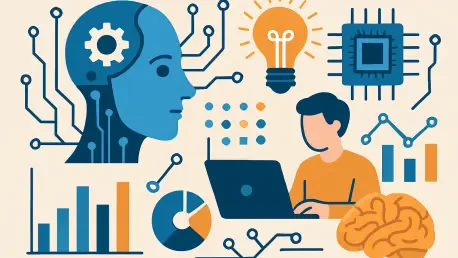In the dynamic realm of data science, 2025 stands as a landmark year where artificial intelligence and analytics are not just tools but the very catalysts propelling industries into a new era of innovation. Across sectors, from technology giants to financial institutions, the race to extract value from data has intensified, driven by staggering investments, pioneering technologies, and collaborative efforts that redefine business strategies. This year, the integration of AI with data analytics has transcended theoretical potential, becoming a tangible force that shapes decision-making and operational efficiency. The news from the week of August 22 offers a compelling glimpse into this transformative landscape, highlighting how companies are leveraging these advancements to stay ahead. As data continues to grow in volume and complexity, the synergy of AI and analytics emerges as the cornerstone of progress, promising to unlock unprecedented opportunities for those ready to adapt and innovate.
Transforming Business with AI-Driven Analytics
The convergence of AI and data analytics marks a seismic shift in how enterprises operate in 2025, turning raw information into a strategic asset with unmatched precision. Companies like Databricks, recently valued at over $100 billion following a monumental funding round, exemplify this trend by enhancing their platforms with AI innovations such as Agent Bricks and the Lakebase operational database. These tools are designed to automate processes and deliver insights at a scale previously unimaginable, empowering businesses to make data-driven decisions swiftly. Beyond mere adoption, this integration signifies a deeper commitment to embedding AI at the core of data strategies, ensuring that organizations can anticipate market shifts and customer needs with greater accuracy. The financial backing behind such initiatives underscores a broader industry conviction that AI is indispensable for maintaining a competitive edge in an increasingly data-centric world.
Equally significant is the momentum seen in other players like Polestar Analytics, which secured $12.5 million to advance its AI and machine learning capabilities within a unified data ecosystem. This funding reflects a targeted effort to bridge disparate data sources, enabling enterprises to harness a cohesive view of their operations and drive actionable outcomes. Unlike broader tech trends, this focus on convergence highlights a nuanced challenge: ensuring that AI doesn’t just process data but transforms it into a seamless, accessible resource for decision-makers. The implications are profound, particularly for industries reliant on real-time insights, where delays or inaccuracies can spell missed opportunities. As these companies push forward, their efforts signal a maturing landscape where AI’s role in analytics isn’t just about innovation but about solving fundamental business problems with precision and foresight.
Pushing Boundaries with Performance Optimization
As the demands of AI-driven workloads escalate, the quest for superior data processing capabilities has become a defining feature of 2025’s tech advancements. Innovations like DataPelago’s Nucleus, a GPU-accelerated data processing library, stand out by delivering exceptional throughput and efficiency, surpassing even established benchmarks in the field. This development isn’t merely a technical feat; it addresses the critical need to manage the ever-growing deluge of data that fuels AI and analytics applications. By optimizing performance, such tools ensure that systems can handle complex computations without bottlenecks, a necessity for businesses aiming to scale their operations. The focus on speed and resource efficiency highlights an industry-wide recognition that raw power alone isn’t enough—smart, streamlined processing is the key to unlocking the full potential of data science.
Beyond individual breakthroughs, this emphasis on performance optimization reflects a broader competitive drive to stay ahead in a data-saturated environment. The ability to process information faster and more effectively directly impacts the quality of insights derived, offering a tangible advantage in sectors where timing is critical, such as finance or e-commerce. Unlike earlier approaches that prioritized volume over velocity, the current trend leans heavily on refining how data is handled, ensuring minimal waste of computational resources. This shift also raises important questions about sustainability, as efficiency gains can reduce energy consumption in data centers—a growing concern as workloads expand. As technologies like Nucleus set new standards, they pave the way for a future where performance isn’t just a metric but a foundational pillar of data-driven innovation.
Accelerating Progress through Strategic Alliances
Collaboration has emerged as a linchpin for scaling AI solutions across diverse enterprise landscapes in 2025, bridging gaps that individual efforts often cannot. A striking example lies in the partnership between UBS and Domino AI, which focuses on refining AI workflows and strengthening governance within the financial services sector. This alliance tackles the intricate challenges of deploying AI in highly regulated environments, where precision and accountability are non-negotiable. By streamlining processes and reducing time-to-value, such partnerships demonstrate that collective expertise can significantly accelerate the adoption of complex technologies. The emphasis on structured cooperation reveals an industry maturing beyond isolated experimentation, prioritizing practical implementation over theoretical promise.
Moreover, strategic alliances like this one underscore the necessity of addressing scalability and reliability in AI deployment, particularly in sectors with stringent compliance demands. Unlike standalone initiatives that may falter under the weight of operational complexities, collaborative approaches leverage combined strengths to navigate regulatory mazes and technical hurdles. This trend extends beyond finance, influencing industries like healthcare and logistics, where the stakes of AI integration are equally high. The focus on governance within these partnerships also signals a proactive stance on mitigating risks, ensuring that AI systems remain trustworthy as they scale. As more organizations recognize the limitations of going it alone, these alliances are likely to become a blueprint for future advancements, fostering an ecosystem where shared goals drive collective success in data science.
Redefining Foundations with Evolving Data Architectures
The rapid ascent of AI is not only transforming tools and applications but also necessitating a fundamental overhaul of data architectures to support next-generation systems. Experts in 2025 are increasingly discussing the transition from the traditional “modern data stack” to an “AI data stack,” a framework tailored for generative AI and autonomous agentic systems. This shift acknowledges that legacy infrastructures often fall short in handling the dynamic, unstructured data demands of advanced AI applications. Thought leaders advocate for reimagined systems that prioritize flexibility and integration, ensuring that data flows seamlessly to fuel intelligent algorithms. Such discussions highlight a critical turning point, where the focus moves from merely collecting data to architecting environments that maximize its utility for AI-driven innovation.
In parallel, concepts like data contracts are gaining traction as mechanisms to ensure quality and accountability in data products, a pressing need as reliance on data intensifies. Unlike earlier paradigms that treated data as a static asset, the current perspective emphasizes its role as a living, evolving resource that requires rigorous standards. Additionally, there’s a growing consensus on balancing AI with analytics, recognizing that the two are complementary rather than competitive. Analytics platforms can leverage AI internally while amplifying the returns on broader AI investments, creating a synergistic effect. This balanced approach challenges the notion of prioritizing one over the other, instead advocating for a holistic strategy that aligns with long-term business goals. As data architectures evolve, they lay the groundwork for a future where AI and analytics coalesce to drive sustainable, impactful progress across industries.
Charting the Path Forward in Data Science
Reflecting on the developments from the week of August 22, the data science landscape in 2025 revealed itself as a vibrant arena of transformation, where AI and analytics intertwined to redefine industry standards. Massive financial commitments, exemplified by Databricks’ towering valuation and Polestar Analytics’ significant funding, underscored the high stakes of integrating AI into data platforms. Technological strides, such as DataPelago’s Nucleus library, pushed performance boundaries, while strategic partnerships like UBS and Domino AI’s collaboration tackled the intricacies of operationalizing AI at scale. Expert insights further enriched the discourse, advocating for redesigned data architectures to support this rapid evolution. Moving forward, the focus should shift to actionable strategies—investing in scalable infrastructure, fostering cross-industry collaborations, and prioritizing governance to ensure reliability. Embracing these steps will solidify the foundation for sustained innovation, ensuring that data science continues to thrive as a driver of business value.









